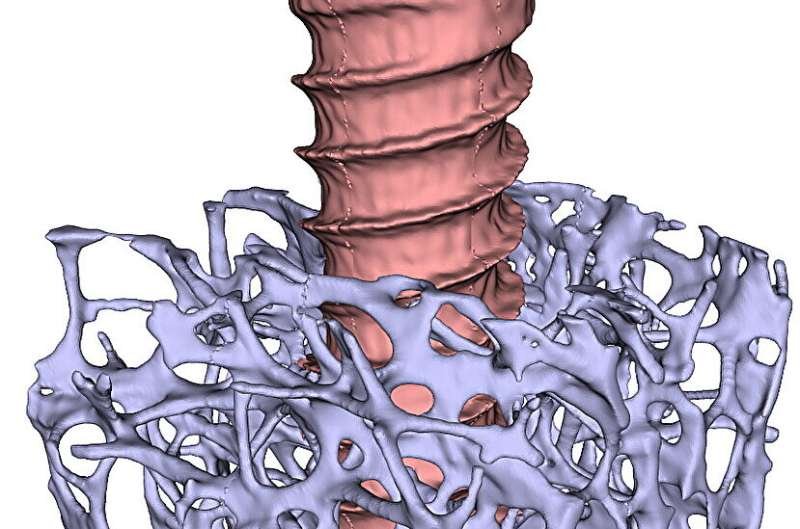
Metal screws are indispensable in bone surgery, but they can fail under everyday stress and complications can occur when screws loosen or even break. Until now, it has been difficult to accurately predict this risk because testing methods have not been able to simulate the real stresses in the body.
Now, a new study published in the Journal of the Mechanical Behavior of Biomedical Materials shows that the risk of failure can be predicted before implantation based on detailed measurements of bone structure.
Using high-resolution micro-CT scans, a team of researchers analyzed 100 bone samples under 10 different load scenarios and identified two key factors that explain up to 90% of the variation in stability. The study, led by the Division of Biomechanics at the Department of Anatomy and Biomechanics at Karl Landsteiner University of Health Sciences (KL Krems), thus provides a model for numerous orthopedic procedures, allowing screws to be implanted more reliably and helping to avoid subsequent complications.
Bones reveal their secret
“We wanted to know if it is possible to predict, even before a screw is implanted, whether it will fail under the forces that are to be expected later,” explains Ass.-Prof. DI Dr. Andreas Reisinger, Head of the Division Biomechanics at the KL Krems. “And our answer is yes—and with astonishing precision.”
Using a micro-computed tomography (CT) scanner in the Bone Laboratory of KL Krems, the team first analyzed the bone structures around the planned implant sites. After implantation, the screws were subjected to load tests simulating everyday movements such as walking or lifting. The result: Bones with higher volume and denser structure provide significantly more support for the screws—regardless of the type of load.
A total of 100 samples of pig bones—which are very similar to human bones—were tested. The screws were subjected to 10 different loading scenarios, including axial (tension and compression), shear, and mixed loading. Six bone parameters were measured. Among these, bone volume (BV) and bone volume fraction (BV/TV—the ratio of bone tissue to total tissue in the tested area) proved to be reliable predictors of the force at which a screw would fail.
Reliable predictions
Using data from the micro-CT images and the measured failure forces of the screws, the team developed two statistical computer prediction models: one based on bone volume alone, and the other combining several bone parameters in a stepwise approach. Both models demonstrated impressive predictive power.
“In all scenarios, we measured the amount of force required for the implanted screws to fail,” explains Prof. Reisinger. “This, of course, varied greatly from sample to sample. And we were able to explain 70—90% of this variance with our models. This is a very clear confirmation of our calculations, which now allow us to make predictions.”
In fact, surgeons could use this information to identify the most stable screw positions in the bone and reduce the risk of later loosening or fracture.
The results of the study at KL Krems open up new perspectives for personalized orthopedics. Especially for older people or patients with osteoporosis, more precise predictions can lead to safer and more effective fixation of damaged bones. The work at KL Krems underlines the value of combining engineering and medicine—and how modern prediction models can help improve treatment outcomes.
More information:
Juan D. Silva-Henao et al, Predicting osteosynthesis screw failure by peri-implant bone morphology in multiple loading conditions, Journal of the Mechanical Behavior of Biomedical Materials (2025). DOI: 10.1016/j.jmbbm.2025.107043
Provided by
Karl Landsteiner University of Health Sciences
Citation:
Bone structure model reveals optimal position for screws in fractures (2025, June 3)
retrieved 3 June 2025
from https://medicalxpress.com/news/2025-06-bone-reveals-optimal-position-fractures.html
This document is subject to copyright. Apart from any fair dealing for the purpose of private study or research, no
part may be reproduced without the written permission. The content is provided for information purposes only.

